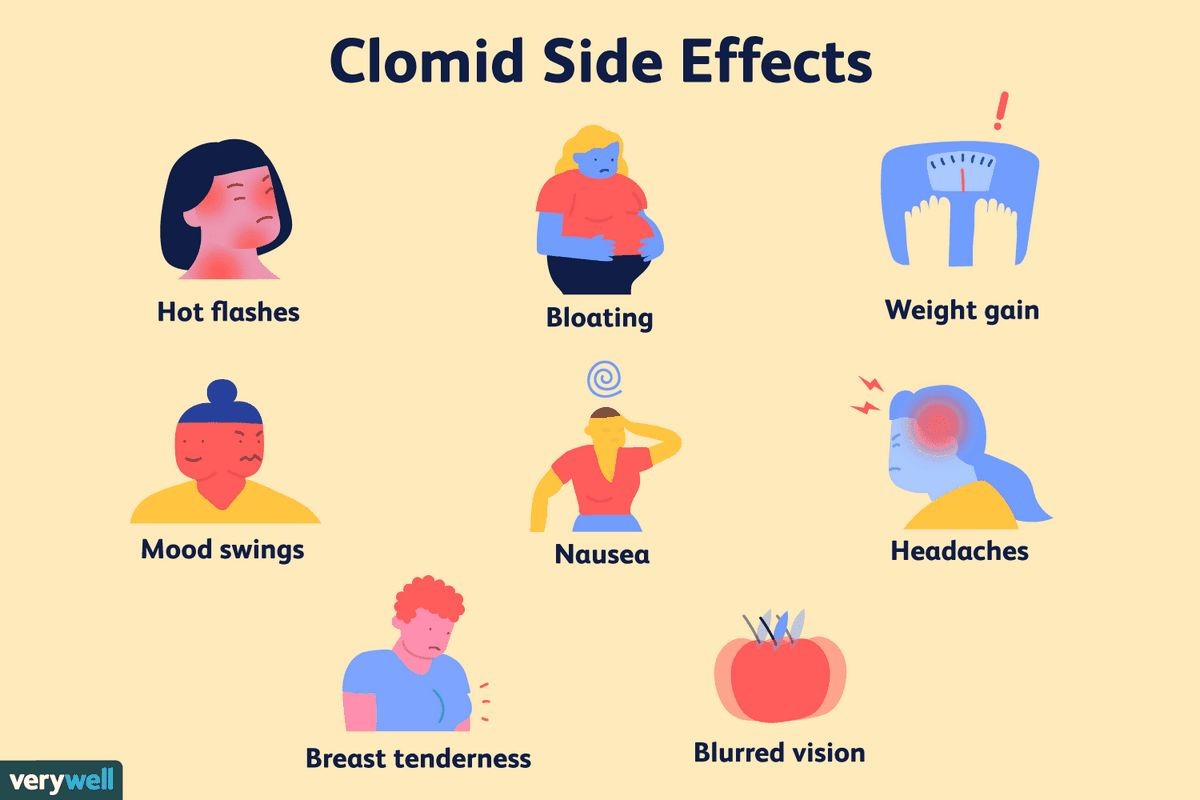
Contents
Side Effects of Clomid (clomiphene)
Clomid (clomiphene) is a nonsteroidal, ovulatory stimulant used to stimulate ovulation in women with ovulatory dysfunction who are not pregnant, do not have abnormal bleeding or ovarian cysts, and have normal liver function.
It binds to estrogen receptors in the hypothalamus, pituitary gland, ovary, endometrium, vagina, and cervix. It causes the production of hormones (gonadotropins) by the pituitary which stimulates ovulation.
Common side effects of Clomid include
- ovarian enlargement,
- flushing,
- stomach discomfort,
- breast discomfort,
- blurred vision,
- nausea,
- vomiting,
- abnormal heart beats,
- acne,
- allergic reactions,
- headaches,
- uterine bleeding,
- back pain,
- and muscle pain.
No drug interactions are listed in the prescribing information for Clomid.
Clomid should not be taken by pregnant women since it does not offer any benefit to pregnant women.
It is unknown if Clomid is excreted into breast milk. It may reduce lactation in some women. Consult your doctor before breastfeeding.
What are the important side effects of Clomid (clomiphene)?
The most common side effects of clomiphene are:
- ovarian enlargement,
- flushing,
- stomach discomfort,
- breast discomfort,
- blurred vision,
- nausea,
- and vomiting.
Other important side effects include
- abnormal heart beats,
- acne,
- allergic reactions,
- headaches,
- uterine bleeding,
- back pain,
- and muscle pain.
Clomid (clomiphene) side effects list for healthcare professionals
Clinical Trial Adverse Events.
Clomid, at recommended dosages, is generally well tolerated. Adverse reactions usually have been mild and transient and most have disappeared promptly after treatment has been discontinued. Adverse experiences reported in patients treated with clomiphene citrate during clinical studies are shown in Table 2.
Table 2. Incidence of Adverse Events in Clinical Studies (Events Greater than 1%) (n = 8029*)
| Adverse Event | % |
| Ovarian Enlargement | 13.6 |
| Vasomotor Flushes | 10.4 |
| Abdominal-Pelvic Discomfort/Distention/Bloating | 5.5 |
| Nausea and Vomiting | 2.2 |
| Breast Discomfort | 2.1 |
| Visual Symptoms | |
| Blurred vision, lights, floaters, waves, unspecified visual complaints, photophobia, diplopia, scotomata, phosphenes | 1.5 |
| Headache | 1.3 |
| Abnormal Uterine Bleeding | 1.3 |
| Intermenstrual spotting, menorrhagia | |
| *Includes 498 patients whose reports may have been duplicated in the event totals and could not be distinguished as such. Also, excludes 47 patients who did not report symptom data. | |
The following adverse events have been reported in fewer than 1% of patients in clinical trials:
- Acute abdomen,
- appetite increase,
- constipation,
- dermatitis or rash,
- depression,
- diarrhea,
- dizziness,
- fatigue,
- hair loss/dry hair,
- increased urinary frequency/volume,
- insomnia,
- light-headedness,
- nervous tension,
- vaginal dryness,
- vertigo,
- weight gain/loss.
Patients on prolonged Clomid therapy may show elevated serum levels of desmosterol. This is most likely due to a direct interference with cholesterol synthesis. However, the serum sterols in patients receiving the recommended dose of Clomid are not significantly altered.
Ovarian cancer has been infrequently reported in patients who have received fertility drugs. Infertility is a primary risk factor for ovarian cancer; however, epidemiology data suggest that prolonged use of clomiphene may increase the risk of a borderline or invasive ovarian tumor.
Postmarketing Adverse Events
The following adverse reactions have been identified during post approval use of Clomid. Because these reactions are reported voluntarily from a population of uncertain size, it is not always possible to reliably estimate their frequency or establish a causal relationship to drug exposure.
Fetal/Neonatal Anomalies:
- Abnormal bone development: skeletal malformations of the skull, face, nasal passages, jaw, hand, limb (ectromelia including amelia, hemimelia, and phocomelia), foot (clubfoot), spine, and joints
- Cardiac abnormalities: septal heart defects, muscular ventricular septal defect, patent ductus arteriosus, tetralogy of Fallot, and coarctation of the aorta
- Chromosomal disorders: Downs syndrome
- Ear abnormalities and deafness
- Gastrointestinal tract abnormalities: cleft lip and palate, imperforate anus, tracheoesophageal fistula, diaphragmatic hernia, omphalocele
- Genitalia abnormalities: hypospadias, cloacal exstrophy
- Lung tissue malformations
- Malformations of the eye and lens (cataract)
- Neoplasms: neuroectodermal tumor, thyroid tumor, hepatoblastoma, lymphocytic leukemia
- Nervous system abnormalities: neural tube defects (anencephaly, meningomyelocele), microcephaly, and hydrocephalus
- Renal abnormalities: renal agenesis and renal dysgenesis
- Others: dwarfism, mental retardation
Genitourinary: Endometriosis, ovarian cyst (ovarian enlargement or cysts could, as such, be complicated by adnexal torsion), ovarian hemorrhage, tubal pregnancy, uterine hemorrhage, reduced endometrial thickness
Hepatic: Transaminases increased, hepatitis
Metabolism Disorders: Hypertriglyceridemia, in some cases with pancreatitis
Neoplasms: Liver (hepatic hemangiosarcoma, liver cell adenoma, hepatocellular carcinoma); breast (fibrocystic disease, breast carcinoma); endometrium (endometrial carcinoma); nervous system (astrocytoma, pituitary tumor, prolactinoma, neurofibromatosis, glioblastoma multiforme, brain abcess); ovary (luteoma of pregnancy, dermoid cyst of the ovary, ovarian carcinoma); trophoblastic (hydatiform mole, choriocarcinoma); miscellaneous (melanoma, myeloma, perianal cysts, renal cell carcinoma, Hodgkin’s lymphoma, tongue carcinoma, bladder carcinoma)
Psychiatric: Anxiety, irritability, mood changes, psychosis
Visual Disorders: Abnormal accommodation, cataract, eye pain, macular edema, optic neuritis, photopsia, posterior vitreous detachment, retinal hemorrhage, retinal thrombosis, retinal vascular spasm, temporary or prolonged loss of vision, possibly irreversible.
Other: Leukocytosis, thyroid disorder
Does Clomid (clomiphene) cause addiction or withdrawal symptoms?
Drug interactions with Clomid have not been documented.
Drug Abuse And Dependence
Tolerance, abuse, or dependence with Clomid has not been reported.
Summary
Clomid (clomiphene) is a nonsteroidal, ovulatory stimulant used to stimulate ovulation in women with ovulatory dysfunction who are not pregnant, do not have abnormal bleeding or ovarian cysts, and have normal liver function. Common side effects of Clomid include ovarian enlargement, flushing, stomach discomfort, breast discomfort, blurred vision, nausea, and vomiting. Clomid should not be taken by pregnant women since it does not offer any benefit to pregnant women. It is unknown if Clomid is excreted into breast milk.


